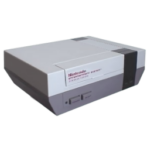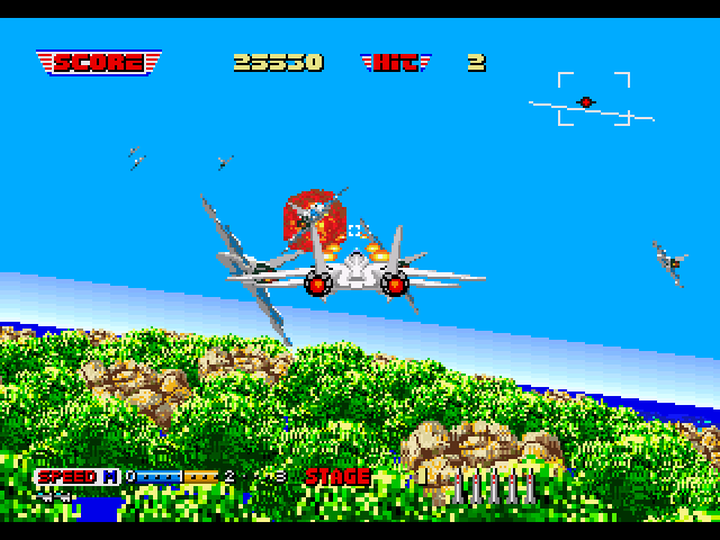
Game Info
Genre: Arcade Shooter / Flight Simulator / Developer: Sega AM2 / Publisher: Sega / Release Date: 1995 / Format Reviewed: Sega 32X / Other Formats: Arcade, Sega Master System, Mega Drive, Sega CD / Players: 1
After Burner Complete on Sega 32X: Arcade Thrills Reviewed
Buckle up and ignite the afterburners! After Burner Complete on the Sega 32X rockets you back to 1995, delivering the high-octane thrills of Sega’s 1987 arcade classic. Developed by Sega AM2 under the legendary Yu Suzuki, this After Burner Complete Sega 32X port aimed to harness the add-on’s 32-bit power to enhance the Mega Drive experience. As a bridge between the Genesis and the Saturn, the 32X promised arcade-perfect action, but did it deliver? This review dives into the gameplay, visuals, and legacy of After Burner Complete, exploring whether it still holds up for retro enthusiasts in 2025.
Historical Background
After Burner first dazzled arcade-goers in 1987 with its hydraulic cabinets and blistering pace, a testament to Sega’s knack for immersive coin-op experiences. By 1995, the Sega 32X was Sega’s attempt to extend the Mega Drive’s lifespan, codenamed “Project Mars” to bridge the gap to the Saturn. After Burner Complete was a key title, ported from the arcade and Mega Drive versions to showcase the 32X’s enhanced graphics and processing power. Unlike the Mega Drive’s 1990 port, which struggled with slowdown and simplified visuals, the 32X version aimed for arcade fidelity. However, the 32X’s rushed 1994 launch and the looming Saturn release limited developer support, resulting in a modest library of 40 titles, including ports like this one.
Gameplay Overview
After Burner Complete puts you in the pilot’s seat of an F-14 Tomcat, tasked with blasting through waves of enemy jets and ground targets across 21 stages. The core objective is simple: survive, shoot, and score. You control your jet with a combination of directional inputs, a machine gun for rapid fire, and limited missiles for high-damage strikes. The game’s pseudo-3D perspective, using sprite scaling, creates a sense of depth as you barrel through canyons and skies, dodging enemy fire and collecting power-ups like extra missiles.
The controls are responsive, with the 32X’s six-button controller allowing precise movement and firing. Stages are short, arcade-style bursts, each ending with a refuelling sequence or boss fight, like massive aircraft carriers. Compared to the Mega Drive version, the 32X port smooths out some control lag and adds more fluid animations, though it retains the arcade’s relentless pace and steep difficulty curve.
Visuals and Audio
Visually, After Burner Complete on Sega 32X shines brighter than its Mega Drive predecessor. The 32X’s 32-bit processors and 3D graphics capabilities boost the colour palette, with richer hues in the skies and more detailed sprites for jets and explosions. The sprite-scaling effects, a hallmark of the arcade original, are smoother, though occasional flicker and slowdown creep in during crowded scenes. Compared to the Mega Drive’s 1990 port, which suffered from choppy scaling and muted colours, the 32X version feels closer to the arcade’s vibrancy.
The audio, however, is a mixed bag. The soundtrack, composed by Hiroshi Kawaguchi, retains the arcade’s iconic chiptune tracks like “Maximum Power” and “Final Take Off,” evoking pure 1980s nostalgia. Sound effects, like missile launches and explosions, are punchy but lack the depth of later 32-bit consoles. The 32X version improves slightly on the Mega Drive’s tinny audio, with crisper samples, but it’s not a night-and-day difference.
Strengths and Highlights
The standout feature of After Burner Complete is its arcade authenticity. The 32X delivers fast, fluid gameplay that captures the coin-op’s relentless energy, making it a joy for fans of reflex-driven shooters. The enhanced visuals, particularly the improved colour depth and smoother scaling, make it a noticeable step up from the Mega Drive port. The game’s pick-up-and-play nature is perfect for quick sessions, and the 32X’s power ensures minimal lag during intense dogfights.
Its simplicity is a double-edged sword but appeals to retro gamers who crave straightforward action. The inclusion of options like adjustable difficulty and control schemes adds some flexibility, a nod to home console players. For 1995, seeing an arcade-perfect After Burner in your living room was a thrill, especially at the 32X’s budget-friendly price point.
Weaknesses and Critiques
Despite its strengths, After Burner Complete has flaws. The gameplay, while exhilarating, grows repetitive due to its arcade roots, designed for short, coin-munching sessions rather than deep home-console experiences. The campaign is brief, clocking in at under an hour, and lacks a narrative to tie stages together. The difficulty spikes sharply, with later stages overwhelming even seasoned players, and the lack of save points or continues can frustrate.
Compared to the Mega Drive version, the 32X port improves visuals but doesn’t overhaul the core experience, making it feel like a polished retread rather than a reinvention. The absence of new content, like additional stages or modes, limits its appeal. Minor slowdown and sprite flicker also persist, a reminder of the 32X’s hardware limitations.
Technical Performance
On the 32X, After Burner Complete leverages the add-on’s dual 32-bit CPUs and 3D graphics processor to deliver smoother performance than the Mega Drive’s 1990 port. The frame rate is generally stable, though it dips during heavy enemy waves. Compared to the arcade, the 32X version is near-identical in layout but lacks the cabinet’s hydraulic immersion. Against the Mega Drive port, the 32X’s enhanced colour palette and sprite scaling are notable upgrades, though it doesn’t match the Saturn’s later ports in polish. Today, it holds up well for retro fans but feels dated next to modern shooters.
Cultural Impact and Legacy
Upon release, After Burner Complete was praised for bringing arcade action home, with reviewers lauding its visuals and speed. However, the 32X’s commercial failure—selling only 665,000 units by late 1994—overshadowed its achievements. The game’s legacy lies in its role as a showcase for the 32X’s potential, though it couldn’t save the add-on from obscurity. Its influence is seen in later Sega shooters, but the arcade original remains the definitive version. Today, it’s a collector’s gem, with cartridges fetching high prices due to the 32X’s rarity.
Personal Take and Modern Appeal
Playing After Burner Complete in 2025 feels like stepping into an arcade time machine. The rush of dodging missiles while blasting enemies is as thrilling as ever, though the lack of depth limits marathon sessions. Retro fans and Sega enthusiasts will love its nostalgia, but casual players may find it too repetitive. It’s best for those who cherish 1980s arcade vibes or want to experience the 32X’s brief moment in the spotlight.
Conclusion
After Burner Complete on Sega 32X is a love letter to arcade purists, delivering fast-paced, visually enhanced action that outshines its Mega Drive counterpart. While repetitive gameplay and limited content hold it back, its nostalgic charm and technical achievements make it a must-play for retro collectors. Dust off your 32X and take to the skies—you won’t regret it!
Coming soon!
Coming soon!
Tips, Tricks, and Cheats
Tip: Memorise enemy patterns in later stages to avoid missile barrages.
Trick: Use the barrel roll (double-tap left or right) to dodge dense bullet patterns.
Cheat: At the title screen, press A + B + C and Start simultaneously to access a secret options menu for extra lives.
Strategy: Save missiles for bosses; the machine gun is sufficient for smaller enemies.
Pro Tip: Adjust the control sensitivity in the options to reduce input lag during tight manoeuvres.


